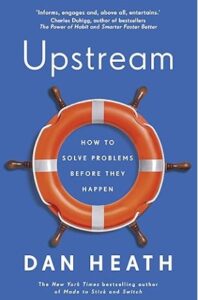What We’re Reading: “Upstream” by Dan Heath
Upstream: The quest to solve problems before they happen by Dan Heath
Advice on how to prevent problems rather than respond to them
For this newsletter’s “What We’re Reading”, I chose Upstream: The quest to solve problems before they happen by Dan Heath, a New York Times bestselling co-author of several books with his brother Chip Heath, including Decisive, Switch, Made to Stick, and The Power of Moments.
In Upstream, Heath explores why human beings struggle to prevent problems before they happen, instead of getting stuck in cycles of response. As Heath puts it, “Cops chase robbers, doctors treat patients with chronic diseases, and call-center reps address customer complaints. But crime and chronic disease and customer complaints are preventable! So why do our efforts skew so heavily toward reaction rather than prevention?” This question felt especially relevant to consider now as the Foundation transitions to a more strategic versus responsive grantmaking model, and for the first time since 1977, awards several multi-year grants to transformational organizations in the workforce development sector.
Heath begins by describing barriers to upstream thinking and our natural reluctance to moving problem solving “upstream”. The barriers he describes help us understand why it is so difficult to get people to commit – both psychologically and financially – to preventative work.
The Three Barriers to Upstream Thinking:
- Problem blindness – when we don’t see a problem, we can’t solve it. In many cases, problematic results are considered natural. We aren’t surprised by outcomes – we’ve become habitualized to accept the less-than-stellar results of our systems and view them as “normal”. That some percentage of students won’t graduate high school, or some percentage of athletes will experience injuries, or some percentage of women will experience sexual harassment in the workplace is viewed as unavoidable. But what if we identified these results as problems that are solvable by reexamining our education system, training regiments, or workplace culture?
- A lack of ownership – once a problem has been identified, the next barrier to upstream solutions is a lack of ownership. Sometimes self-interest is to blame, but often the lack of ownership is less nefarious and more complicated – responsibility for an outcome is fragmented between many different parties. In the case of high school graduation rates, students, parents, teachers, principals, superintendents) or people are reluctant to take on a problem because they don’t feel it’s their place to do so
- Tunneling – humans, like all animals, are designed to prioritize immediate threats. It is often difficult to focus on what’s going on outside the “tunnel” of the urgent demands on our time and efforts. Thinking about future problems and how to prevent them seems impossible when there are so many other things, both personal and professional, that need to get done today.
Once a problem has been identified, someone or a group of people have agreed to take ownership, and been given the space to do so, Heath offers a series of seven questions as a guide to ensuring action that maximizes prevention and avoids harm. The questions he suggests in the book offer a way to approach the work systematically and with the greatest likelihood of achieving success.
I enjoyed this book and would recommend it to anyone. Heath includes fascinating stories and examples from all walks of life to illustrate his points, and the lessons he delivers can be applied to almost any problem a person, organization, or society is facing. As the Knott Foundation launches our strategic grantmaking initiative with the goal of making a real impact in the areas of workforce development, youth development, and Catholic schools, Heath’s questions are ones we will be asking of ourselves and our nonprofit partners.

